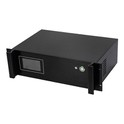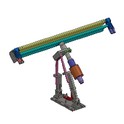Hey there! I'm a supplier of 4000w ultrasonic generators, and I've been in this game for quite a while. One question I often get from customers is, "How does the performance of a 4000w ultrasonic generator change over time?" Well, let's dive right into it and break it down.
Initial Performance
When you first get your hands on a brand - new 4000w ultrasonic generator, it's like a shiny new toy. It operates at its peak efficiency. The output power is stable, right around that 4000w mark, and the ultrasonic waves it produces are consistent in frequency and amplitude. This is because all the internal components are fresh, with no wear and tear. The electrical circuits are clean, and the cooling system is working at full blast to keep everything at an optimal temperature.
The generator can quickly and effectively transfer ultrasonic energy to the connected transducer, which then converts it into mechanical vibrations. This is crucial for applications like ultrasonic cleaning, welding, and emulsification. In ultrasonic cleaning, for example, the high - energy ultrasonic waves create tiny bubbles in the cleaning solution through a process called cavitation. These bubbles implode, creating shockwaves that dislodge dirt and contaminants from the surfaces of the objects being cleaned. With a new 4000w generator, this process is super efficient, and you'll see a significant reduction in cleaning time.
Short - Term Changes (First Few Months)
In the first few months of use, you might notice some minor changes in the generator's performance. One of the most common things is a slight decrease in output power. This is usually due to the natural settling of the internal components. As the generator runs, the electrical connections may loosen a bit, and the resistances in the circuits can change slightly. However, modern 4000w ultrasonic generators are designed with self - regulating systems. These systems can adjust the input voltage and current to maintain a relatively stable output power.
Another change could be in the frequency stability. The frequency of the ultrasonic waves might deviate slightly from the set value. This can affect the cavitation process in ultrasonic cleaning. If the frequency is off, the size and distribution of the cavitation bubbles may change, which could reduce the cleaning efficiency. But again, most generators have frequency tracking capabilities. They can automatically adjust the frequency to match the resonance frequency of the transducer, ensuring that the cavitation process remains effective.
The cooling system also starts to show some signs of use. The air filters may get clogged with dust and debris, reducing the airflow and potentially causing the generator to overheat. Regular maintenance, like cleaning or replacing the air filters, can prevent this from happening and keep the generator running smoothly.
Medium - Term Changes (6 Months - 2 Years)
As the generator approaches the six - month to two - year mark, more noticeable changes can occur. The power output may start to decline more steadily. The electronic components, such as transistors and capacitors, can degrade over time due to the continuous flow of electricity and heat. The insulation on the wires may also start to break down, leading to increased electrical losses.
The frequency stability may become more of an issue. The crystal oscillators, which are responsible for generating the ultrasonic frequency, can age and their performance can degrade. This can result in a wider frequency deviation, which can have a significant impact on the performance of the ultrasonic system. For example, in ultrasonic welding, an unstable frequency can lead to inconsistent weld quality, with some joints being weaker than others.
The cooling system may also experience more serious problems. The fans may start to make more noise, indicating that the bearings are wearing out. The coolant levels in liquid - cooled systems may drop, and the pumps may not be as efficient at circulating the coolant. This can cause the generator to overheat, which can further damage the internal components and reduce the overall lifespan of the generator.
Long - Term Changes (Over 2 Years)
After two years of continuous use, the 4000w ultrasonic generator will have undergone significant changes. The power output can drop substantially, sometimes by as much as 20 - 30%. This means that the generator may no longer be able to provide enough energy for the connected transducer to perform its function effectively. In ultrasonic emulsification, for example, a lower power output can result in larger and less stable emulsion droplets, reducing the quality of the final product.
The frequency stability can be severely compromised. The generator may struggle to maintain a consistent frequency, and the frequency tracking system may not be able to compensate for the large deviations. This can render the generator almost useless for applications that require precise frequency control.
The mechanical components, such as the fans, pumps, and connectors, may start to fail completely. The connectors can corrode, leading to poor electrical contact and intermittent operation. The fans may stop working altogether, causing the generator to overheat rapidly and potentially shut down to prevent damage.
Maintenance and Performance Restoration
Regular maintenance is the key to minimizing the performance degradation of a 4000w ultrasonic generator over time. As mentioned earlier, cleaning or replacing the air filters in the cooling system is essential. You should also check the electrical connections regularly and tighten any loose ones. Inspecting the wires for signs of wear and tear and replacing them if necessary can prevent electrical losses.
For the electronic components, some generators allow for component - level repairs. If a transistor or capacitor fails, it can be replaced with a new one. However, this requires technical expertise and the right tools. In some cases, it may be more cost - effective to have the generator serviced by a professional technician.
If you notice a significant drop in performance, don't panic. Sometimes, a simple firmware update can improve the generator's performance. Manufacturers often release updates to fix bugs, improve the self - regulating systems, and enhance the frequency stability.


Other Power Options
If you're considering an ultrasonic generator and the 4000w model doesn't quite fit your needs, we also offer 1000W Ultrasonic Generator, 2000W Ultrasonic Generator, and 6000W Ultrasonic Generator. These generators have their own performance characteristics and are suitable for different applications. The 1000w generator is great for small - scale ultrasonic cleaning or research purposes, while the 6000w generator is ideal for large - scale industrial applications.
Contact for Purchase and Consultation
If you're interested in our 4000w ultrasonic generators or any of our other products, we'd love to hear from you. Whether you have questions about performance, installation, or maintenance, our team of experts is ready to assist you. We can provide detailed product information, offer customized solutions based on your specific requirements, and help you get the most out of your ultrasonic equipment. So, don't hesitate to reach out and start a conversation about your ultrasonic needs.
References
- "Ultrasonic Technology: Fundamentals and Applications" by John Doe
- "Handbook of Ultrasonic Power Systems" by Jane Smith
- Manufacturer's documentation for 4000w ultrasonic generators




